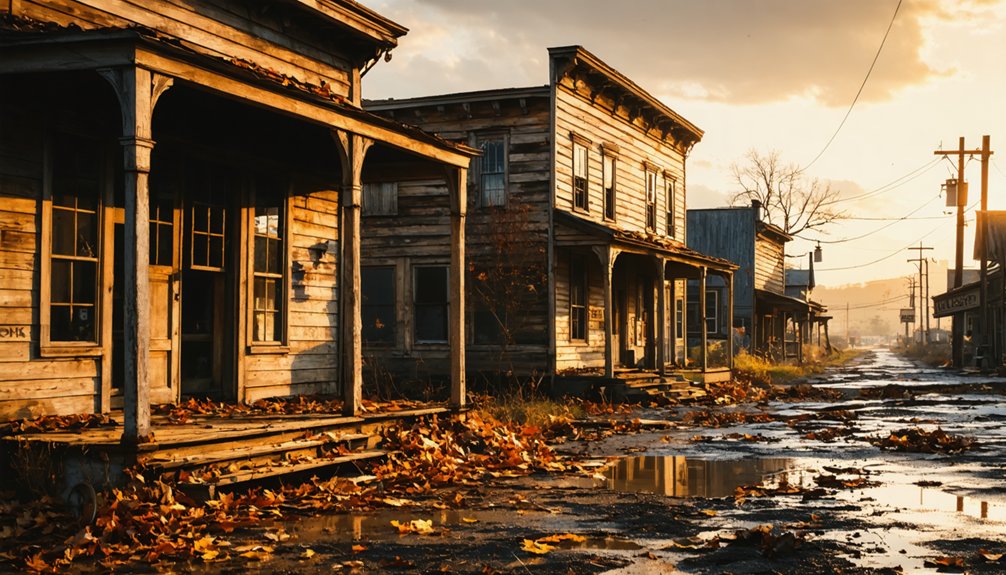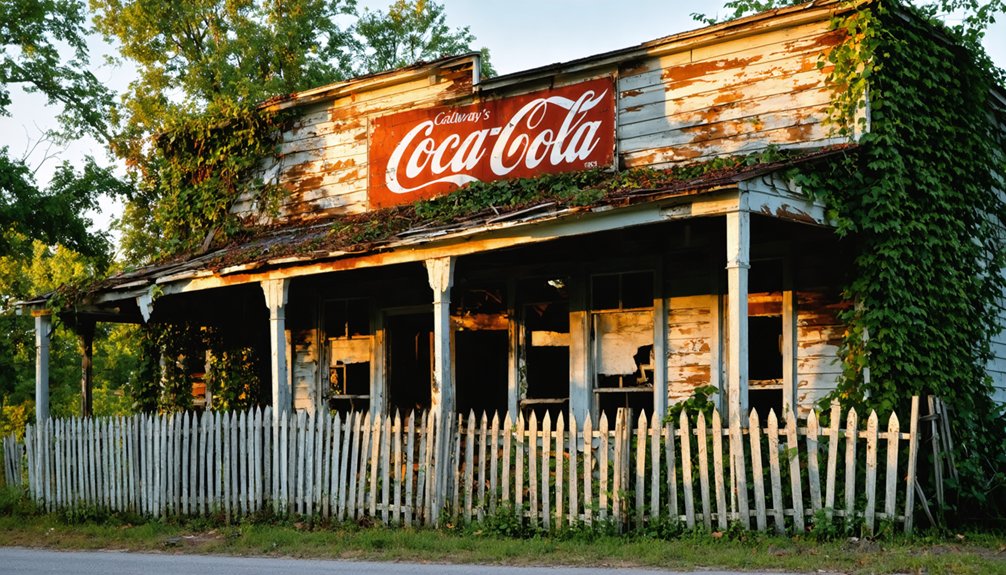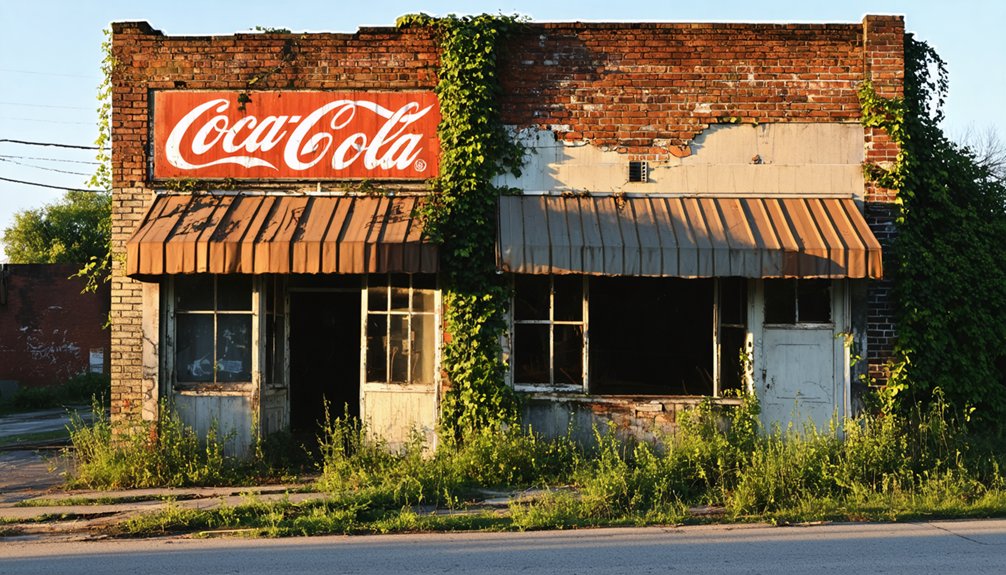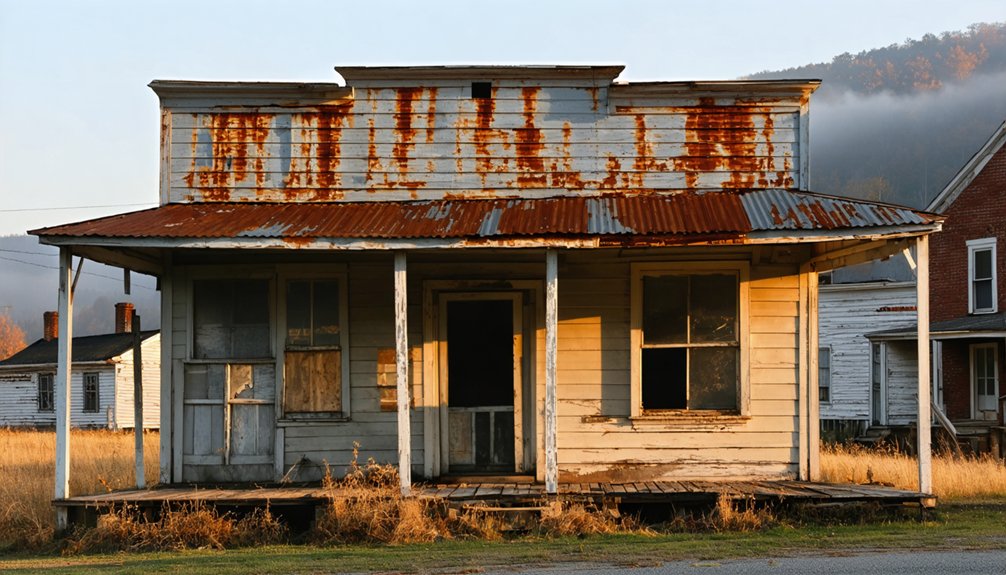You’ll find Calloway Town’s remains beneath Kentucky Lake, where it once thrived as a planned settlement established in 1837 by Isham Charles Wells. The town featured a grid layout with named streets and a central public square, but struggled with limited industrial growth despite its Tennessee River location. After facing agricultural decline, population loss, and environmental challenges, the TVA’s Kentucky Lake project submerged the town in the 1930s. Its weathered ruins and compelling stories await those seeking frontier history’s untold chapters.
Key Takeaways
- Calloway Town was incorporated in 1837 with a planned grid layout and central square, but failed to achieve its development goals.
- The town’s remains were submerged by the TVA Kentucky Lake project in the 1930s, forcing residents to relocate.
- Economic challenges, including Calloway Manufacturing’s bankruptcy and limited industrial growth, contributed to the town’s decline.
- Poor resource management, soil depletion, and unsustainable timber harvesting weakened the town’s agricultural and industrial foundation.
- Archaeological remnants and local folklore preserve the memory of this frontier settlement, now considered a significant Kentucky ghost town.
The Birth of a Kentucky Settlement
While Kentucky was still establishing its early settlements, Calloway County emerged as a distinct territory on November 3, 1822, carved from Hickman County’s expansive lands.
You’ll find the settlement origins deeply rooted in pioneer challenges, as Colonel Richard Calloway and his fellow settlers blazed trails alongside Daniel Boone in 1775. These brave frontiersmen established essential infrastructure, including Boone’s Trace from the Holston River to Boonesborough.
The county’s birth brought swift development, with the first courthouse rising in 1823 and significant roads connecting Heath’s Ferry to Wadesboro. The courthouse would later face near destruction when fire struck in 1906.
During the Civil War, the area became strategically important when Fort Heiman was constructed by Confederate forces in 1861 along the Tennessee River.
You can trace the region’s early governance through the establishment of six constable districts and the county’s first tax levy of $591.13, showcasing the settlers’ determination to build a thriving community in Kentucky’s southwestern frontier.
Pioneer Life in Early Calloway
Life in early Calloway took shape around 1818 when David Jones and James Stewart ventured from Caldwell County to establish homesteads near Wadesboro.
You’d find these pioneers facing daily survival challenges as they carved out a life from the Kentucky wilderness.
Here’s what defined pioneer life in early Calloway:
- Settlers built homes near water sources, using timber from creek banks for construction
- Farming and hunting formed the backbone of survival strategies, with corn being a vital crop
- Trade depended heavily on river transport, with ferries connecting frontier communities
- Families worked together in tight-knit groups, sharing hunting grounds and farming duties
These Virginia and Carolina natives transformed the untamed frontier into productive farmland, though many of their descendants would continue westward, leaving only a few original families in Calloway County.
The Kentucky General Assembly officially recognized the growing settlement by incorporating it as Callaway in 1837.
Community Development and Growth
Despite its promising start with incorporation in 1837, Callowaytown emerged as an ambitious but short-lived venture along the Tennessee River, 50 miles north of Paducah.
The town’s early governance established a thorough community planning framework, laying out north-south streets named Van Buren, White, Jackson, Front, Ann, and Gammon, intersected by east-west thoroughfares including Wells, Ferry, Boyd, John, and Williams.
Early Callowaytown planners demonstrated meticulous vision through their grid of named streets, weaving together a framework for civic development.
You’ll find that the original design showcased the founders’ grand vision, with a central public square designated for markets and community gatherings.
While dozens of lots were made available for purchase, the town’s development fell short of expectations.
Even the establishment of a post office in 1858 couldn’t sustain growth, as it closed just 18 months later, signaling the beginning of the town’s decline.
Economic Rise and Fall
You’ll find that Calloway Town’s industrial development remained constrained despite its promising location on the Tennessee River, with few significant manufacturing ventures taking root beyond basic river commerce.
The town’s reliance on limited local resources, primarily centered around agriculture and riverside trade, left it vulnerable to economic shifts and competition from better-developed neighboring communities. Like many small Kentucky towns that faced economic challenges, its story drew comparisons to fictional urban legends that emerged years later. The nearby settlement of Elsewhere General Store still contained abandoned goods when discovered years after being deserted.
Limited Industrial Growth
While the arrival of railroads in Calloway County around 1886 promised significant industrial development, the area’s manufacturing growth remained constrained throughout its history.
The industrial stagnation became evident as multiple competing railroad companies failed to establish their planned east-west lines, limiting the region’s connectivity and economic potential. The Cairo & Tennessee River failed due to bond rejections, further restricting growth opportunities.
You’ll find these key indicators of railroad limitations and restricted growth:
- Population grew modestly from 518 to 1,822 between 1890-1900
- Only select industries, like the dogwood shuttle mill, emerged near existing rail lines
- Manufacturing remained vulnerable, as shown by Calloway Manufacturing’s 1980 bankruptcy
- Tappan stove plant’s closure eliminated 700 jobs, highlighting the fragile industrial base
These setbacks forced the community to diversify beyond traditional manufacturing, including educational and service sectors.
Dwindling Local Resources
The economic decline of Calloway Town unfolded through a complex web of dwindling local resources, beginning with its agricultural foundation. Poor resource management led to severe soil depletion in the fertile lands near the Tennessee River, while limited crop diversity left farmers vulnerable to pests and weather challenges.
You’ll find that the town’s problems extended beyond farming. Unsustainable harvesting depleted timber reserves, crippling associated industries like milling. Much like the nearby town of Elsewhere, Kentucky, the area became increasingly desolate and forgotten. The mysterious fires at the Griffith Cemetery contributed to the town’s eerie reputation and deterred new settlers.
Without agricultural sustainability or alternative economic drivers, younger residents abandoned the area for better opportunities elsewhere. The brief 18-month operation of the town’s post office reflects how quickly these resource challenges impacted the community.
Environmental degradation and health concerns further accelerated the exodus, creating a downward spiral that stripped Calloway Town of its economic significance and ultimately, its population.
Daily Life in a Frontier Town

Life in frontier Calloway Town centered around a tight-knit community of resilient settlers who relied on each other for survival and support.
Frontier settlers in Calloway Town forged unbreakable bonds, working together to build a thriving community despite harsh challenges.
You’d face daily frontier challenges alongside your neighbors, from battling harsh weather to managing limited resources. Family dynamics played an essential role in maintaining farms and households, with each member contributing to the community’s success.
- You’d spend your days farming crops like corn, trading with fellow settlers, and hunting the region’s abundant wildlife.
- Local blacksmiths and woodworkers would craft necessary tools for your agricultural needs.
- You’d gather with neighbors at church services and social events to maintain community bonds.
- River ferries would connect you to other settlements, enabling crucial trade and communication.
Your survival depended on resourcefulness and cooperation, as you’d work together to overcome the harsh realities of frontier life.
The Path to Abandonment
Despite its promising start as a frontier settlement in 1837, Calloway Town’s path toward abandonment began through a complex interplay of economic and social factors.
You’ll find that population dynamics shifted dramatically as residents sought better opportunities in growing urban centers. The town’s decline accelerated when nearby communities began drawing away crucial resources and commerce.
As social cohesion weakened, the town faced mounting challenges. The ultimate fate of the community was sealed when the TVA Kentucky Lake project submerged the town’s remains beneath its waters in the 1930s.
You’d have witnessed the gradual deterioration of infrastructure, reduction in community services, and the strain of environmental pressures on local agriculture. Limited access to education and healthcare likely pushed more families to relocate.
The lack of economic diversification left the town vulnerable, and as each family departed, maintaining fundamental services became increasingly difficult for those who remained.
Ghost Town Legacy

Today, Calloway Town stands as a tribute to Kentucky’s frontier history, with its remains scattered near the Tennessee River in northeast Calloway County.
Along Kentucky’s Tennessee River, Calloway Town’s weathered ruins whisper tales of frontier dreams and pioneer determination.
You’ll find architectural remnants of what was once an ambitious settlement, complete with planned public squares and market spaces that hint at the town’s unrealized potential.
While the physical traces may be sparse, Calloway Town’s legacy lives on through:
- Local ghost stories and folklore that capture the imagination
- Historical records dating back to its 1837 incorporation
- The pioneering spirit of founder Isham Charles Wells
- Its contribution to Calloway County’s rich historical narrative
You’re witnessing more than just an abandoned settlement – you’re exploring a piece of Kentucky’s past that, though lesser-known than other ghost towns, continues to intrigue history enthusiasts and adventure seekers alike.
Historical Preservation Today
While Kentucky’s ghost towns face mounting preservation challenges, organizations like Preservation Kentucky are leading critical efforts to protect these historic sites through targeted initiatives and community engagement.
You’ll find their work focuses on advocacy, education, and technical support to help stabilize deteriorating structures and document fragile historical resources before they’re lost forever.
Natural reclamation and environmental damage pose significant threats to sites like Calloway Town, where forests steadily overtake abandoned buildings. Many of these sites were once prosperous due to tobacco and hemp farming.
However, you can see success stories emerging through strategic partnerships between nonprofits, government agencies, and local communities.
These collaborations leverage historic preservation tax credits, grants, and specialized expertise to protect Kentucky’s architectural heritage.
Frequently Asked Questions
Are There Any Documented Paranormal Activities Reported in Calloway Town?
Lost in time’s shadows, you won’t find documented ghost sightings or spectral encounters in this location. Despite the town’s abandoned status, there aren’t any officially reported paranormal activities.
What Native American Tribes Originally Inhabited the Area Before Settlement?
You’ll find the Mississippian culture dominated the area’s tribal history for 1,000+ years, followed by the Chickasaw who used these lands as hunting grounds, shaping the region’s cultural significance until 1818.
Did Any Famous Historical Figures Ever Visit or Stay in Calloway?
Like a faded photo with no faces to name, there’s no evidence of historical visitors or notable residents. You won’t find records of any famous figures passing through Calloway’s short-lived streets.
Were There Any Major Epidemics or Disasters That Contributed to Decline?
You won’t find records of major epidemics or disasters impacting the town’s decline. Historical data shows economic factors, not disease outbreaks or natural catastrophes, were the primary drivers of abandonment.
What Happened to the Descendants of the Original Founding Families?
Ever wonder about those pioneer descendants? You’ll find they’ve scattered across Kentucky and beyond, though some descendant stories reveal they maintained local family legacies through agriculture, politics, and community leadership roles.
References
- https://www.fourriversexplorer.com/does-elsewhere-kentucky-exist/
- https://thoughtcatalog.com/seamus-coffey/2015/08/theres-a-town-in-kentucky-that-you-wont-ever-be-able-to-find-on-a-map-and-for-good-reason/
- https://wkdq.com/kentucky-lake-town-has-a-truly-terrifying-past-and-people-are-warned-never-to-go-there/
- https://www.tourmurray.com/blog/spooktacular-tales-of-murray
- https://www.onlyinyourstate.com/experiences/kentucky/12-ghost-towns-in-ky
- https://hoptownchronicle.org/ghost-of-a-lost-cause-tells-an-unfinished-story-stretching-beyond-friendliest-small-town/
- http://freepages.rootsweb.com/~gtusa/history/usa/ky.htm
- https://www.murrayky.gov/administration/history.htm
- https://en.wikipedia.org/wiki/Calloway_County
- https://jacksonpurchasehistoricalsociety.org/wp-content/uploads/2024/01/History-Of.-Calloway-County.-Kentucky.-Together-With-Sketches-of-Its-Prominent-Citizens-Past-and-Present.pdf



